Human/Mouse/Rat p62/SQSTM1 Antibody Summary
Asp368-Leu440
Accession # Q13501
Applications
Please Note: Optimal dilutions should be determined by each laboratory for each application. General Protocols are available in the Technical Information section on our website.
Scientific Data
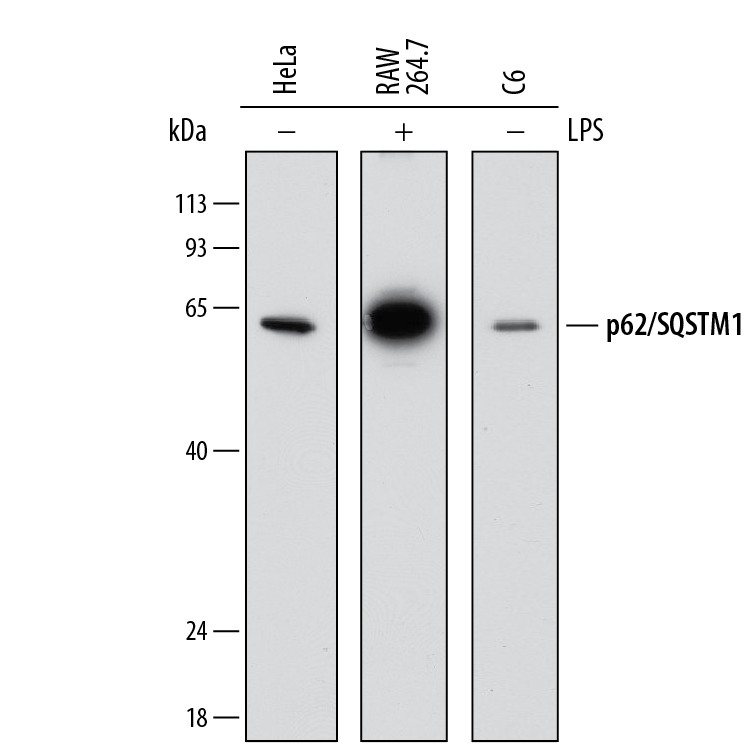 View Larger
View Larger
Detection of Human, Mouse, and Rat p62/SQSTM1 by Western Blot. Western blot shows lysates of HeLa human cervical epithelial carcinoma cell line, RAW 264.7 mouse monocyte/macrophage cell line, and C6 rat glioma cell line untreated (-) or treated (+) with 1 µg/mL LPS for 24 hours. PVDF membrane was probed with 2 µg/mL of Mouse Anti-Human/Mouse/Rat p62/SQSTM1 Monoclonal Antibody (Catalog # MAB8028) followed by HRP-conjugated Anti-Mouse IgG Secondary Antibody (HAF018). A specific band was detected for p62/SQSTM1 at approximately 62 kDa (as indicated). This experiment was conducted under reducing conditions and using Immunoblot Buffer Group 1.
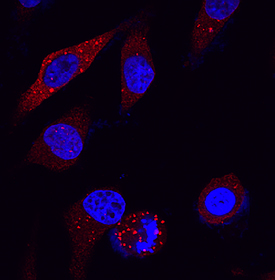 View Larger
View Larger
p62/SQSTM1 in HeLa Human Cell Line. p62/SQSTM1 was detected in immersion fixed HeLa human cervical epithelial carcinoma cell line using Mouse Anti-Human/Mouse/Rat p62/SQSTM1 Monoclonal Antibody (Catalog # MAB8028) at 25 µg/mL for 3 hours at room temperature. Cells were stained using the NorthernLights™ 557-conjugated Anti-Mouse IgG Secondary Antibody (red; NL007) and counterstained with DAPI (blue). Specific staining was localized to phagosomes in cell cytoplasm. View our protocol for Fluorescent ICC Staining of Cells on Coverslips.
 View Larger
View Larger
p62/SQSTM1 in Human Liver. p62/SQSTM1 was detected in immersion fixed paraffin-embedded sections of human liver using Mouse Anti-Human/Mouse/Rat p62/SQSTM1 Monoclonal Antibody (Catalog # MAB8028) at 5 µg/mL for 1 hour at room temperature followed by incubation with the Anti-Mouse IgG VisUCyte™ HRP Polymer Antibody (VC001). Before incubation with the primary antibody, tissue was subjected to heat-induced epitope retrieval using Antigen Retrieval Reagent-Basic (CTS013). Tissue was stained using DAB (brown) and counterstained with hematoxylin (blue). Specific staining was localized to nuclei and cytoplasm in hepatocytes. Staining was performed using our protocol for IHC Staining with VisUCyte HRP Polymer Detection Reagents.
 View Larger
View Larger
Detection of Mouse p62/SQSTM1 by Simple WesternTM. Simple Western lane view shows lysates of RAW 264.7 mouse monocyte/macrophage cell line untreated (-) or treated (+) with 1 µg/mL LPS for 24 hours, loaded at 0.2 mg/mL. A specific band was detected for p62/SQSTM1 at approximately 66 kDa (as indicated) using 20 µg/mL of Mouse Anti-Human/Mouse/Rat p62/SQSTM1 Monoclonal Antibody (Catalog # MAB8028). This experiment was conducted under reducing conditions and using the 12-230 kDa separation system.
 View Larger
View Larger
p62/SQSTM1 Specificity is Shown by Immunocytochemistry in Knockout Cell Line. p62/SQSTM1 was detected in immersion fixed HeLa human cervical epithelial carcinoma cell line but is not detected in p62/SQSTM1 knockout (KO) HeLa cell line using Mouse Anti-Human/Mouse/Rat p62/SQSTM1 Monoclonal Antibody (Catalog # MAB8028) at 3 µg/mL for 3 hours at room temperature. Cells were stained using the NorthernLights™ 557-conjugated Anti-Mouse IgG Secondary Antibody (red; NL007) and counterstained with DAPI (blue). Specific staining was localized to cytoplasm. View our protocol for Fluorescent ICC Staining of Cells on Coverslips.
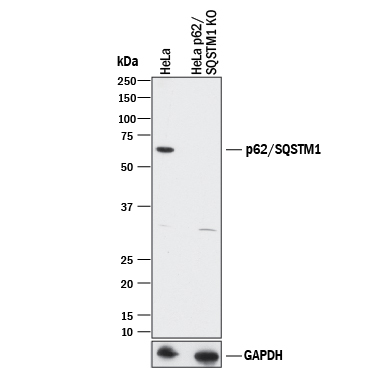 View Larger
View Larger
Western Blot Shows Human p62/SQSTM1 Specificity Using Knockout Cell Line. Western blot shows lysates of HeLa human cervical epithelial carcinoma parental cell line and p62/SQSTM1 knockout HeLa cell line (KO). PVDF membrane was probed with 2 µg/mL of Mouse Anti-Human/Mouse/Rat p62/SQSTM1 Monoclonal Antibody (Catalog # MAB8028) followed by HRP-conjugated Anti-Mouse IgG Secondary Antibody (HAF018). A specific band was detected for p62/SQSTM1 at approximately 62 kDa (as indicated) in the parental HeLa cell line, but is not detectable in the knockout HeLa cell line. GAPDH (MAB5718) is shown as a loading control. This experiment was conducted under reducing conditions and using Immunoblot Buffer Group 1.
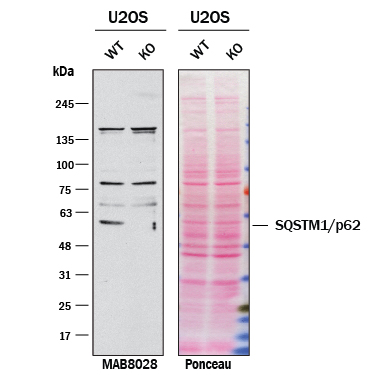 View Larger
View Larger
Western Blot Shows Human p62/SQSTM1 Specificity Using Knockout Cell Line. Western blot shows lysates of U2OS human osteosarcoma cell line and p62/SQSTM1 knockout U2OS cell line (KO). Nitrocellulose membrane was probed with 0.5 µg/mL of Mouse Anti-Human/Mouse/Rat p62/SQSTM1 Monoclonal Antibody (Catalog # MAB8028) followed by HRP-conjugated Anti-Mouse IgG Secondary Antibody. A specific band was detected for p62/SQSTM1 at approximately 62 kDa (as indicated) in the parental U2OS cell line, but is not detectable in knockout U2OS cell line. The Ponceau stained transfer of the blot is shown. This experiment was conducted under reducing conditions. Image, protocol, and testing courtesy of YCharOS Inc. See ycharos.com for additional details.
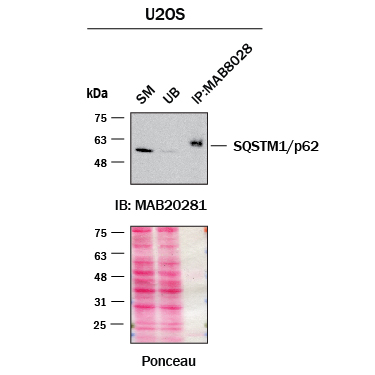 View Larger
View Larger
Detection of SQSTM1/p62 by Immunoprecipitation Immunoprecipitation was performed on cell lysate of U2OS human osteosarcoma cell line using 1.0 μg of Mouse Anti-Human SQSTM1/p62 Monoclonal Antibody (Catalog # MAB8028) pre-coupled to protein G or protein A beads. Immunoprecipitated SQSTM1/p62 was detected with Rabbit Anti-SQSTM1/p62 Monoclonal Antibody (Catalog # MAB80281). The Ponceau stained transfers of each blot are shown. SM=10% starting material; UB=10% unbound fraction; IP=immunoprecipitated. Image, protocol, and testing courtesy of YCharOS Inc. (ycharos.com).
Reconstitution Calculator
Preparation and Storage
- 12 months from date of receipt, -20 to -70 °C as supplied.
- 1 month, 2 to 8 °C under sterile conditions after reconstitution.
- 6 months, -20 to -70 °C under sterile conditions after reconstitution.
Background: p62/SQSTM1
SQSTM1 (Sequestrome-1), also called p62, is a widely expressed, stress-inducible, multifunctional 62 kDa intracellular protein. The 440 amino acid (aa) human SQSTM1 contains multiple adaptor domains that allow interaction with proteins in NGF/NFkB and other signaling pathways (notably TRAF6, atypical protein kinase C family and Src family), polyubiquitin, proteasome subunits and many others. It contains numerous regulatory phosphorylation sites and a dimerization site. SQSTM1 shuttles ubiquitinylated proteins to the proteasome and is important in autophagy and apoptosis. Its dysregulation is associated with Paget’s disease of bone, Parkinson’s and Alzheimer’s diseases, and cancers. Within aa 344-440, which includes the ubiquitin-binding domain, human SQSTM1 shares 100% aa sequence identity with mouse and rat SQSTM1.
Product Datasheets
Citations for Human/Mouse/Rat p62/SQSTM1 Antibody
R&D Systems personnel manually curate a database that contains references using R&D Systems products. The data collected includes not only links to publications in PubMed, but also provides information about sample types, species, and experimental conditions.
7
Citations: Showing 1 - 7
Filter your results:
Filter by:
-
Role of macrophage autophagy in postoperative pain and inflammation in mice
Authors: Mitsui, K;Hishiyama, S;Jain, A;Kotoda, Y;Abe, M;Matsukawa, T;Kotoda, M;
Journal of neuroinflammation
Species: Mouse
Sample Types: Cell Lysates
Applications: Western Blot -
Airway Smooth Muscle Cell Mitochondria Damage and Mitophagy in COPD via ERK1/2 MAPK
Authors: L Fang, M Zhang, J Li, L Zhou, M Tamm, M Roth
International Journal of Molecular Sciences, 2022-11-12;23(22):.
Species: Human
Sample Types: Cell Lysates
Applications: Western Blot -
Inhibition of Carbonic Anhydrase 2 Overcomes Temozolomide Resistance in Glioblastoma Cells
Authors: K Zhao, A Schäfer, Z Zhang, K Elsässer, C Culmsee, L Zhong, A Pagenstech, C Nimsky, JW Bartsch
International Journal of Molecular Sciences, 2021-12-23;23(1):.
Species: Human
Sample Types: Cell Lysates
Applications: Western Blot -
Rapid 3D phenotypic analysis of neurons and organoids using data-driven cell segmentation-free machine learning
Authors: P Mergenthal, S Hariharan, JM Pemberton, C Lourenco, LZ Penn, DW Andrews
PLoS computational biology, 2021-02-22;17(2):e1008630.
Species: Human
Sample Types: Whole Cells
Applications: ICC -
Wnt/&beta-catenin signaling pathway induces autophagy-mediated temozolomide-resistance in human glioblastoma
Authors: EJ Yun, S Kim, JT Hsieh, ST Baek
Cell Death Dis, 2020-09-17;11(9):771.
Species: Human
Sample Types: Cell Lysates
Applications: Western Blot -
Cold-inducible RNA-binding protein through TLR4 signaling induces mitochondrial DNA fragmentation and regulates macrophage cell death after trauma
Authors: Z Li, EK Fan, J Liu, MJ Scott, Y Li, S Li, W Xie, TR Billiar, MA Wilson, Y Jiang, P Wang, J Fan
Cell Death Dis, 2017-05-11;8(5):e2775.
Species: Mouse
Sample Types: Cell Lysates
Applications: Western Blot -
Tribbles Pseudokinase 3 Induces Both Apoptosis and Autophagy in Amyloid-? induced Neuronal Death
Authors: Suraiya Saleem
J. Biol. Chem, 2016-12-23;0(0):.
Species: Mouse, Rat
Sample Types: Cell Lysates, Whole Cells
Applications: ICC, Western Blot
FAQs
No product specific FAQs exist for this product, however you may
View all Antibody FAQsReviews for Human/Mouse/Rat p62/SQSTM1 Antibody
Average Rating: 5 (Based on 2 Reviews)
Have you used Human/Mouse/Rat p62/SQSTM1 Antibody?
Submit a review and receive an Amazon gift card.
$25/€18/£15/$25CAN/¥75 Yuan/¥2500 Yen for a review with an image
$10/€7/£6/$10 CAD/¥70 Yuan/¥1110 Yen for a review without an image
Filter by:



